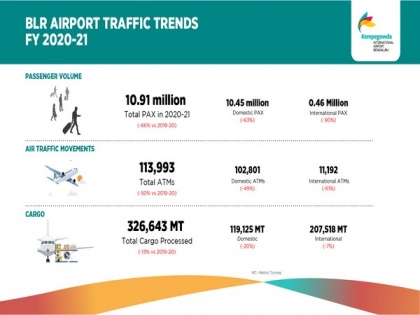Passenger traffic at Bengaluru Airport plummets by 66 percent in FY 2020-21
By ANI | Published: June 26, 2021 05:13 AM2021-06-26T05:13:19+5:302021-06-26T05:20:02+5:30
As the COVID-19 pandemic continues to affect the aviation sector, Kempegowda International Airport, Bengaluru on Friday informed that passenger traffic at Bengaluru airport has plummeted by 66 per cent in Financial Year 2020-21.

Passenger traffic at Bengaluru Airport plummets by 66 percent in FY 2020-21
As the COVID-19 pandemic continues to affect the aviation sector, Kempegowda International Airport, Bengaluru on Friday informed that passenger traffic at Bengaluru airport has plummeted by 66 per cent in Financial Year 2020-21.
In a tweet by the airport, it read, "#COVID19 has dealt a major blow to the #aviation industry, impacting passenger volumes and revenues. Passenger traffic at #BLRAirport plummeted by 66% in FY 2020-21. We welcomed only 10.91 million passengers in FY2020-21."
As per the official release, the COVID-19 pandemic has dealt a major blow to the aviation industry, severely impacting passenger volumes, as well as revenues. Kempegowda International Airport, Bengaluru (KIAB/ BLR Airport), which managed a record 32.3 million passengers in FY2019-20, witnessed an unprecedented 66 percent decline in traffic during FY2020-21. During this period, BLR Airport welcomed only 10.91 million passengers since domestic air travel resumed in India on May 25, 2020, following a two-month suspension. 10.45 million passengers flew domestic routes, recording a 63 percent drop, as compared to 27 million in FY 2019-20. International routes witnessed 4 million passengers in 2019-20 - the passenger footfall, however, declined substantially to 0.46 million in FY2020-21, a decline of 90 percent. This is mainly attributed to the continued suspension of international flights and COVID-19 restrictions across the globe. After showing signs of recovery during the middle of the fiscal year, the traffic dropped significantly due to the rise in the number of COVID-19 cases in India, beginning February 2021. The reduced slots for airlines at airports driven by DGCA guidelines, too, added to the lowered numbers. ATMs dropped by 50 percent to113,993 from 231,051 in 2019-20. While domestic movements reduced by 49 percent at 102,801, international traffic saw 11,192 movements, lower by 61 percent in the last 311 days of operations. However, the subdued environment due to the pandemic had a marginal impact on cargo operations. The cargo processed during FY2020-21 was 326,643 Metric Tonnes (MT), 12.70 percent short of last fiscal's 374,181 MT. BLR Airport was the only major Airport in the country to reach 100 percent of the previous year's tonnage on a year-on-year basis from September 2020 through January 2021. In March, it regained momentum, recording 34,401 MT - the highest in the last 31 months. Overall, domestic tonnage was 119,125 MT, 20 percent short of last year's tonnage, while international was 207,518 MT, 7% short of the previous financial year. The outbreak of COVID-19 has had a catastrophic effect on the aviation industry. Due to the sharp drop in passenger volumes, BLR Airport has suffered a significant decline in revenue. Despite the crisis, Bangalore International Airport Limited (BIAL) is firmly committed to completing all the capital expenditure projects that are currently underway. During the last financial year, BIAL also launched multiple cargo infrastructure projects including a new Express Cargo Terminal and a Public Bonded Warehouse and made several investments in technology to ensure passengers continue to enjoy an enhanced airport experience and to ensure cargo processing was expedited. Despite reduced passenger footfall, BIAL also continued to ensure that air travel was made safer by introducing innovative technologies. Contactless processing was introduced, enabling passengers to travel from parking to boarding without having to touch multiple surfaces and with minimal human intervention. To complement the contactless process, BIAL continued to expand the DigiYatra facial biometric technology, enabling paperless travel for passengers to by simply enrolling their facial biometrics and validating their ID card. The other notable tech interventions during the year include the Virtual Information Desk and a Queue Management System to ensure that passengers feel safe while passing through the Airport during the pandemic. The Virtual Information Desk enables passengers to have real-time conversations with Airport staff located remotely, over touch-free video. The Queue Management System displays live waiting times on the screens at processing points, leading to lowered levels of stress for passengers.
( With inputs from ANI )
Disclaimer: This post has been auto-published from an agency feed without any modifications to the text and has not been reviewed by an editor
Open in app